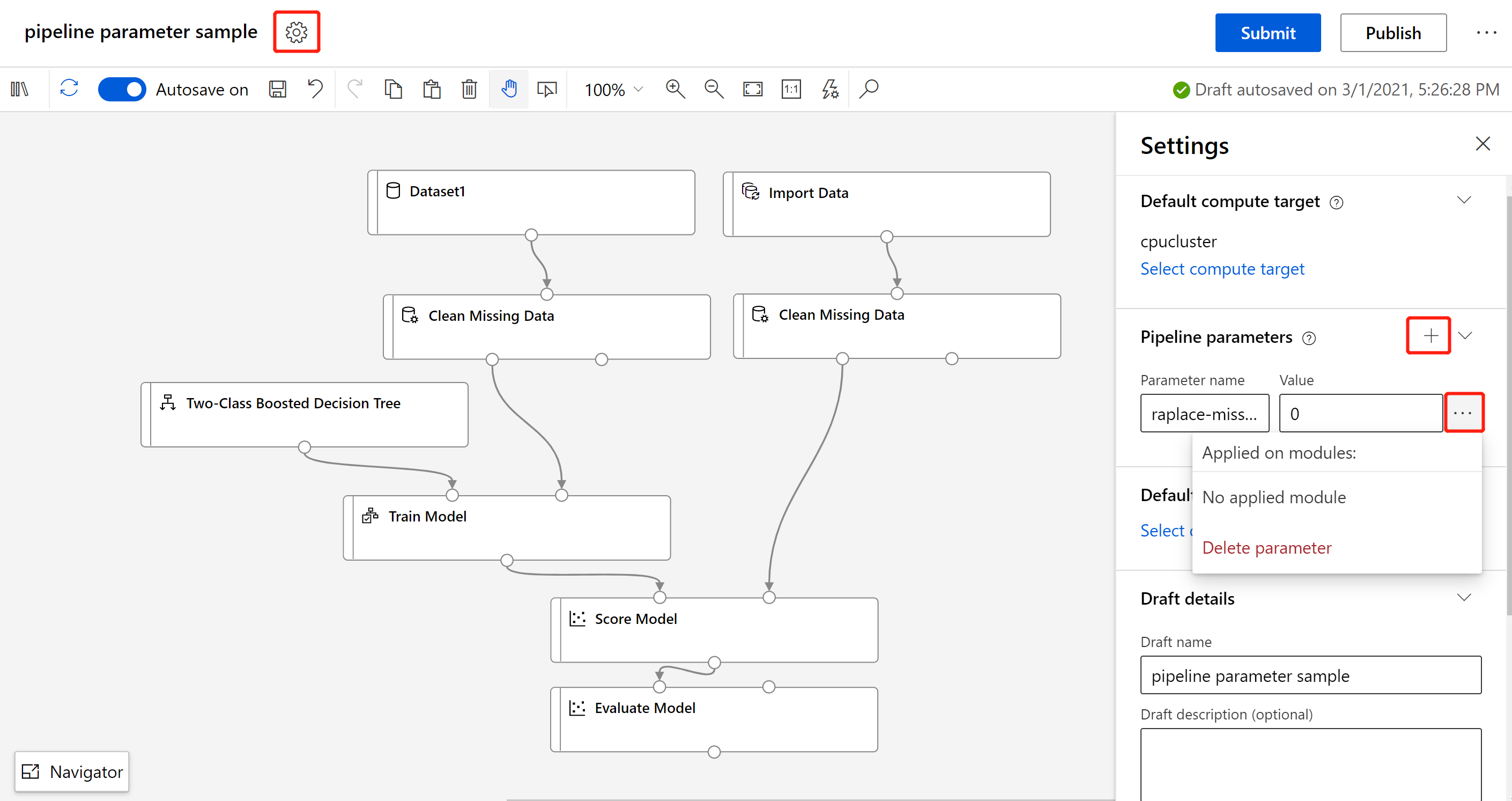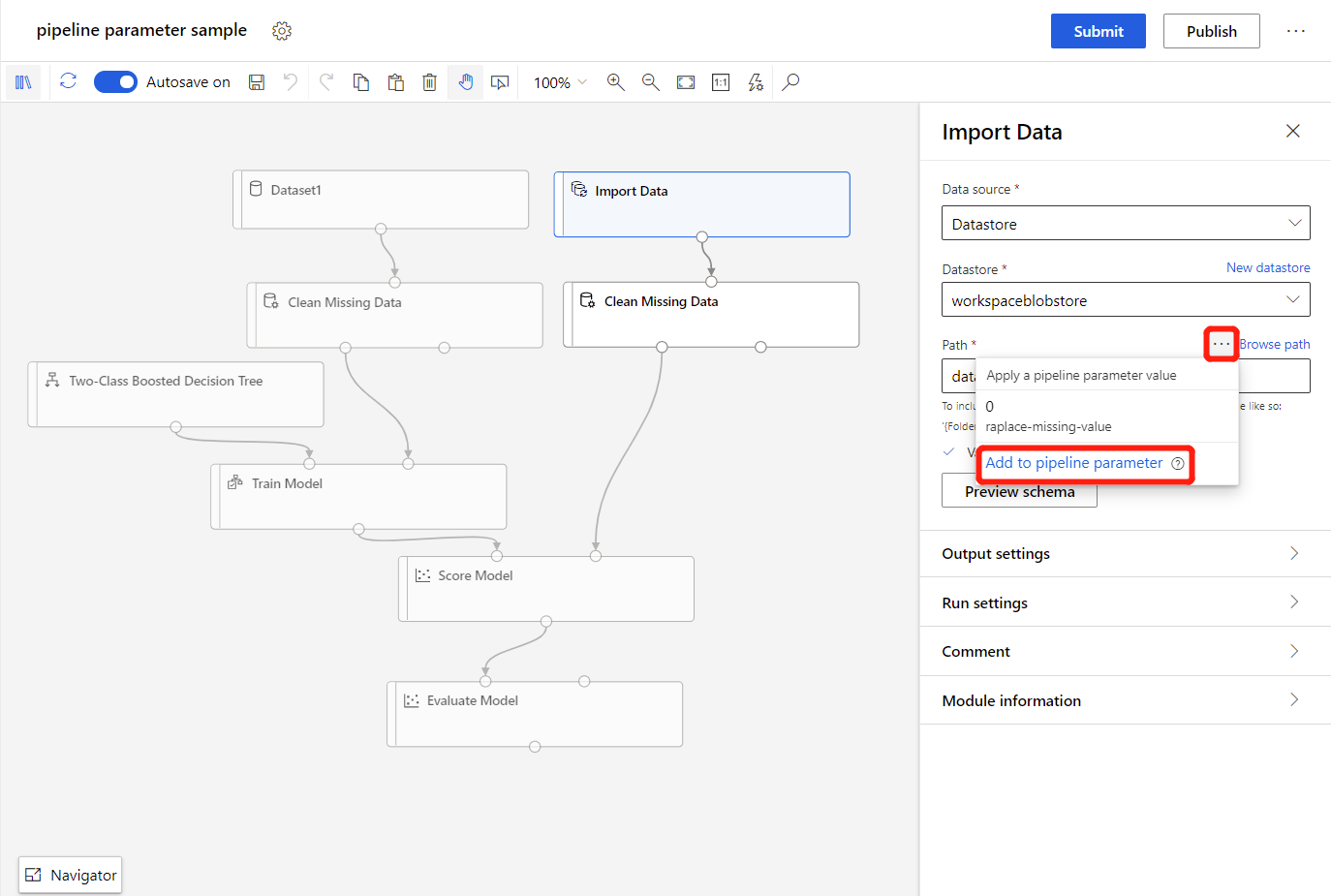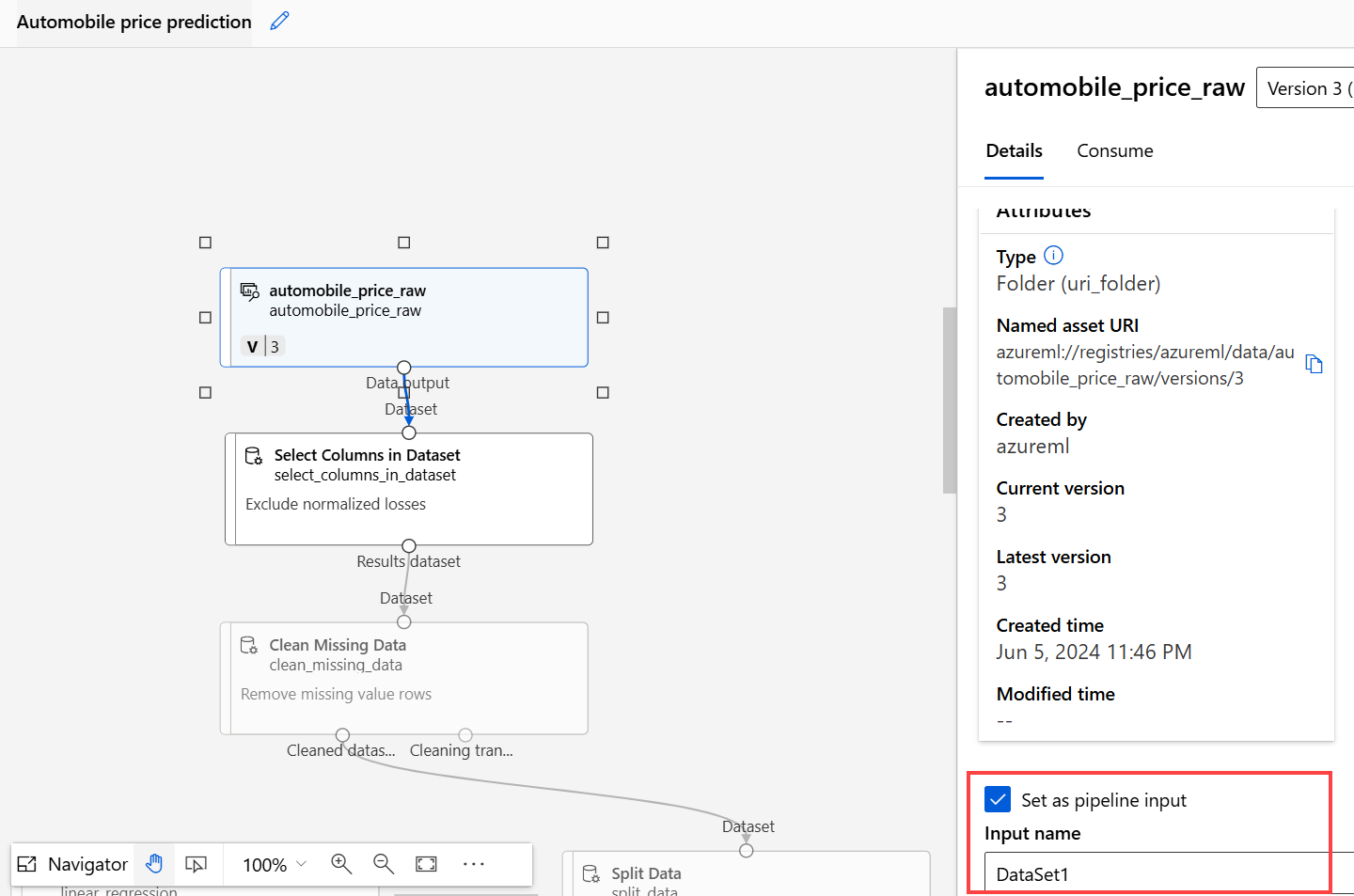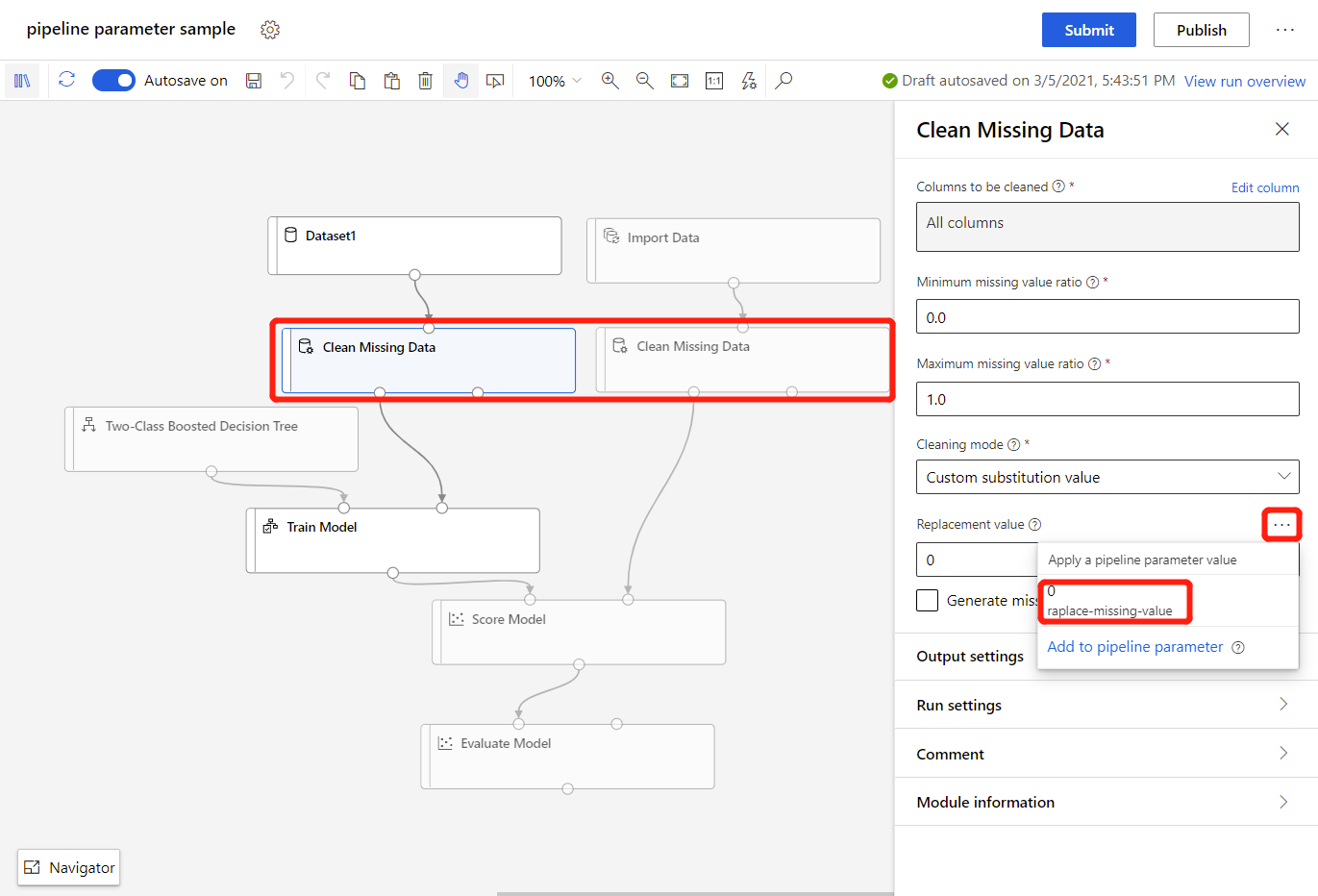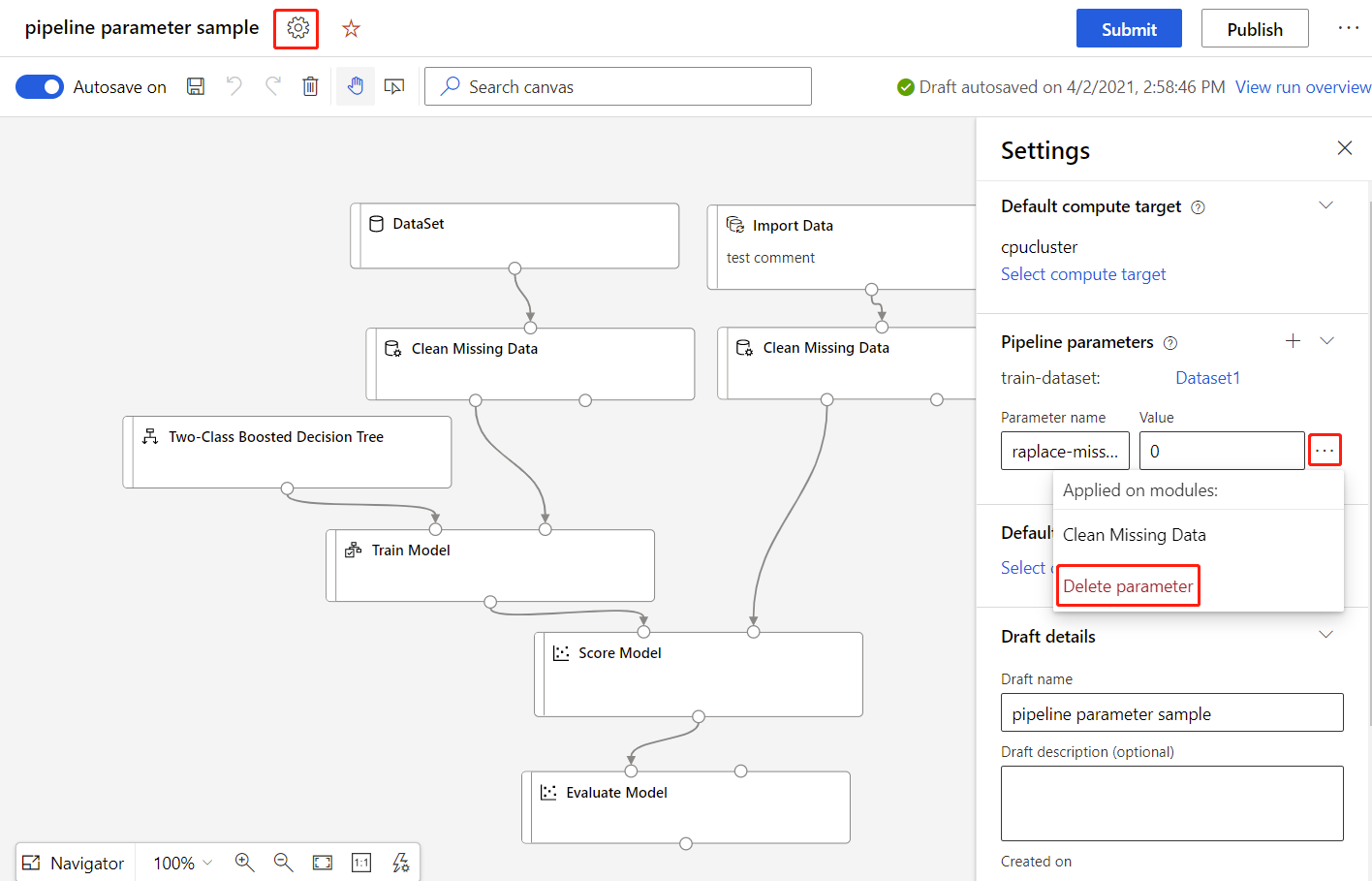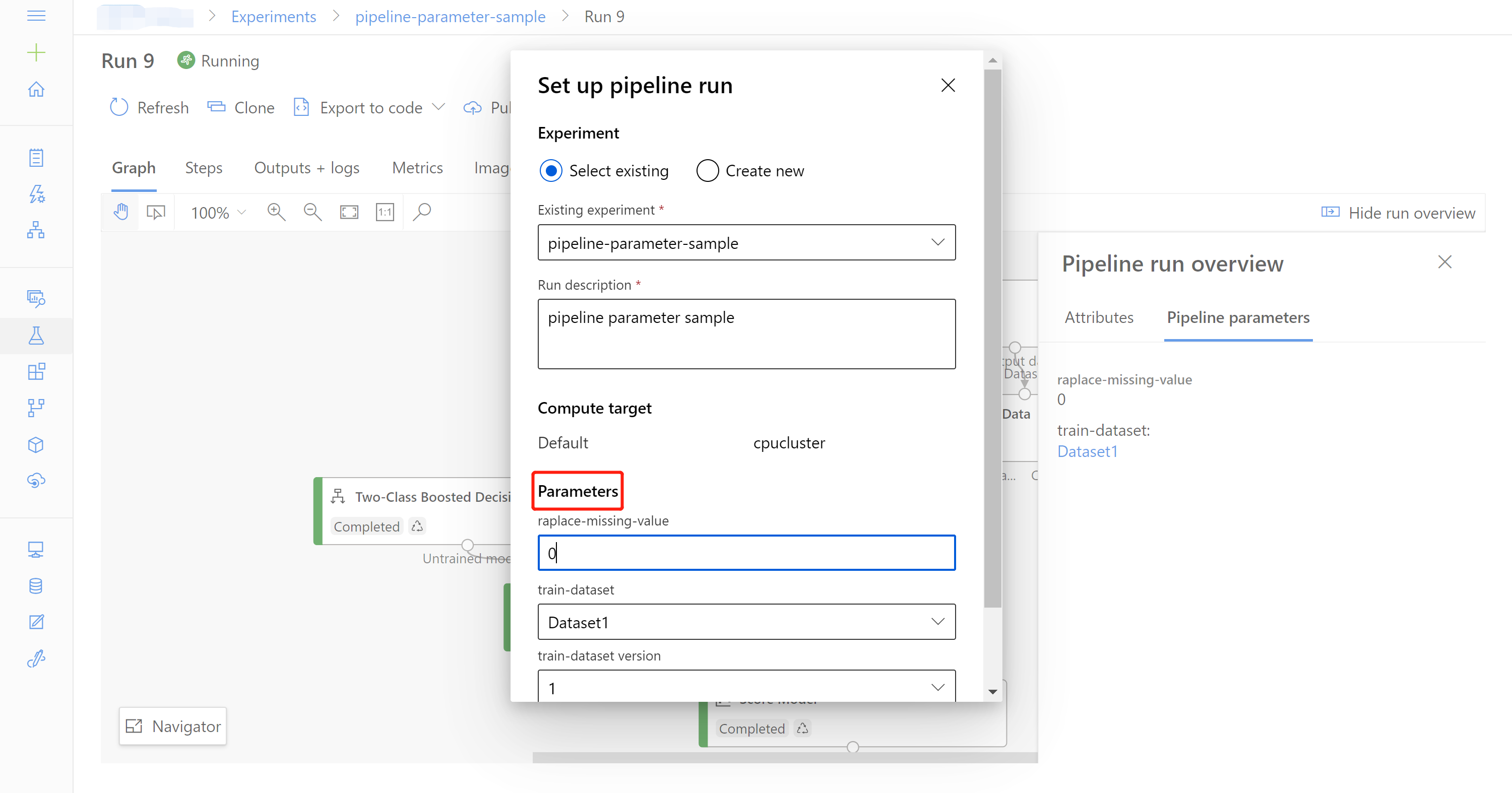Note
Access to this page requires authorization. You can try signing in or changing directories.
Access to this page requires authorization. You can try changing directories.
Important
This article provides information on using the Azure Machine Learning SDK v1. SDK v1 is deprecated as of March 31, 2025. Support for it will end on June 30, 2026. You can install and use SDK v1 until that date.
We recommend that you transition to the SDK v2 before June 30, 2026. For more information on SDK v2, see What is Azure Machine Learning CLI and Python SDK v2? and the SDK v2 reference.
This article describes how to use pipeline parameters to build flexible pipelines in the Azure Machine Learning designer. Pipeline parameters enable you to dynamically set values at runtime so you can encapsulate pipeline logic and reuse assets.
Pipeline parameters are especially useful when you resubmit a pipeline job, retrain models, or perform batch predictions.
In this article, you learn how to do the following:
- Create pipeline parameters.
- Delete and manage pipeline parameters.
- Supply pipeline parameters when you trigger pipeline jobs.
Prerequisites
An Azure Machine Learning workspace. See Create workspace resources.
A pipeline draft.
For a guided introduction to the designer, complete the designer tutorial.
Important
If you don't see the UI elements mentioned in this article, such as buttons in studio or designer, you might not have the right level of permissions for the workspace. Contact your Azure subscription administrator to verify that you're granted the correct level of access. For more information, see Manage users and roles.
Create a pipeline parameter
There are three ways to create a pipeline parameter in the designer:
- Create a pipeline parameter in the settings panel and bind it to a component.
- Promote a component parameter to a pipeline parameter.
- Promote a dataset to a pipeline parameter.
Note
Pipeline parameters support only basic data types, like int, float, and string.
Option 1: Create a pipeline parameter in the settings panel
In this section, you create a pipeline parameter in the settings panel.
In your pipeline draft, select Pipeline interface.
In the Pipeline interface section, select the + button and then select a parameter type, for example,
Double.Enter a name for the parameter and a default value.
For example, enter
minimum-missing-value-ratio-2as input name and0.1as the default value.Select Save.
After you create a pipeline parameter, you must attach it to the component parameter that you want to dynamically set.
Option 2: Promote a component parameter
The easiest way to create a pipeline parameter for a component value is to promote a component parameter. Use the following steps to promote a component parameter to a pipeline parameter:
Double-click the component you want to attach a pipeline parameter to.
Select the ellipsis button (...) next to the parameter that you want to specify.
Select Add to pipeline input.
Enter an input name and a default value.
Select Save.
You can now specify new values for this parameter anytime you submit the pipeline.
Option 3: Promote a dataset to a pipeline parameter
If you want to submit your pipeline with variable datasets, you need to promote your dataset to a pipeline parameter:
Double-click the dataset you want to turn into a pipeline parameter.
In the details pane of the dataset, select Set as pipeline input.
Select Save.
You can now specify a different dataset by using the pipeline parameter the next time you run the pipeline.
Attach a component parameter to or detach a component parameter from a pipeline parameter
In this section, you learn how to attach a component parameter to a pipeline parameter and how to detach a component parameter from a pipeline parameter.
Attach a component parameter to a pipeline parameter
You can attach the component parameters of duplicated components to the same pipeline parameter if you want to alter the value one time when you trigger the pipeline job.
In the following example, the Clean Missing Data component is duplicated. For each Clean Missing Data component, attach a Minimum missing value ratio to the pipeline parameter minimum-missing-value-ratio-2:
Double-click the Clean Missing Data component.
Select the ellipsis button (...) above the Minimum missing value ratio box.
Select the pipeline parameter
minimum-missing-value-ratio-2.Select Save.
You have successfully attached the Minimum missing value ratio field to your pipeline parameter.
Detach a component parameter from a pipeline parameter
When you detach a component parameter from a pipeline parameter, it's not actionable.
You can detach a component parameter from a pipeline parameter by selecting the ellipsis button (...) next to the component parameter and then selecting Detach from pipeline input.
Update and delete pipeline parameters
In this section, you learn how to update and delete pipeline parameters.
Update pipeline parameters
Complete the following steps to update a component pipeline parameter:
- To the right of the canvas, select Pipeline interface.
- You can view and update the names and default values for all of your pipeline parameters.
Delete a dataset pipeline parameter
Complete the following steps to delete a dataset pipeline parameter:
- Double-click the dataset component.
- Clear the Set as pipeline input checkbox.
- Select Save.
Delete component pipeline parameters
Complete the following steps to delete a component pipeline parameter:
To the right of the canvas, select Pipeline interface.
Select the recycle bin icon next to the pipeline parameter.
Confirm the deletion in the resulting pop-up window.
Note
Deleting a pipeline parameter causes all attached component parameters to be detached. The values of detached component parameters will keep current pipeline parameter values.
Supply pipeline parameters when you trigger a pipeline job
In this section, you learn how to supply pipeline parameters when you submit a pipeline job.
Resubmit a pipeline job
After you submit a pipeline with pipeline parameters, you can resubmit the job with different parameters:
Go to pipeline detail page. In the Pipeline run overview pane, you can check current pipeline parameters and values.
Select Resubmit.
In the Set up pipeline job window, specify your new pipeline parameters.
Use published pipelines
You can also publish a pipeline to use its pipeline parameters. A published pipeline is a pipeline that has been deployed to a compute resource. Client applications can invoke the pipeline via a REST endpoint.
Published endpoints are especially useful for retraining and batch prediction scenarios. For more information, see How to retrain models in the designer or Run batch predictions in the designer.
Next steps
In this article, you learned how to create pipeline parameters in the designer. Next, see how you can use pipeline parameters to retrain models or perform batch predictions.
You can also learn how to use pipelines programmatically with the SDK v1.
